Spotlight on the editors of Tribeca Film Festival 2022

Adobe is excited to celebrate the filmmakers at this year’s Tribeca Film Festival, taking place in New York City from June 8-19.
With filmmakers and studios continuing to rely on remote collaboration and workflows across cities, states, and even countries, we’re proud to see so many projects using tools like Premiere Pro, After Effects, and Frame.io to get the job done. We spoke to some of this year’s festival editors and post-production professionals about their projects, their favorite Adobe Creative Cloud tips and tricks, and their advice to aspiring filmmakers.
Get to know the editors
- Courtney Ware — editor of ACIDMAN
- David Lawrence, editor/co-producer of Lynch/Oz
- Julian Robinson — editor and co-producer of It Ain’t Over
- Daniel Garber — editor of The Drop
- Bryan Mason editor/cinematographer of Good Luck To You Leo Grande
- Harrison Atkins — editor of Good Girl Jane and The Year Between
- Nick Garnham Wright — editor for On the Line: The Richard Williams Story
- Daniel Antebi — director/writer/editor of God’s Time
- Mike Selemon — editor, LAND OF DREAMS
Courtney Ware — editor of ACIDMAN
How and where did you first learn to edit?
I am actually a self-taught editor. As a kid, I loved to make my own movies and tell stories — which of course meant I needed to edit what I shot. I learned at a pretty young age the power of cutting from one shot to the other and pairing images with music. My first work on a narrative project was when I was hired by a director I had previously assisted to media manage a project. I asked if I could cut a few scenes together, and it sort of turned into an assistant editor gig. The first film that I was sole editor for was my directorial feature debut. To say I learned a ton about storytelling and editing on that project is an understatement.
What do you like about Premiere Pro, and/or any of the other tools you used?
It’s really important to me for the tools that I use to be intuitive and fast. When I’m editing in Premiere Pro, the software itself essentially disappears and is just a conduit to carve out the story. There have been many times when I’ve said to myself “I wonder if I can….” and then found the exact tool that I needed in Premiere Pro.
Who is your creative inspiration and why?
I am always so inspired by my fellow friends and collaborators. I seem to always be learning things from them. But if I had to narrow it down, I’d say Lisa Churgin. I had the opportunity early in my editing career to show her in progress cuts and talk about the art of editing. Her career has been such an inspiration. I’m super thankful to have such a prolific female editor that I can look up to and call on.
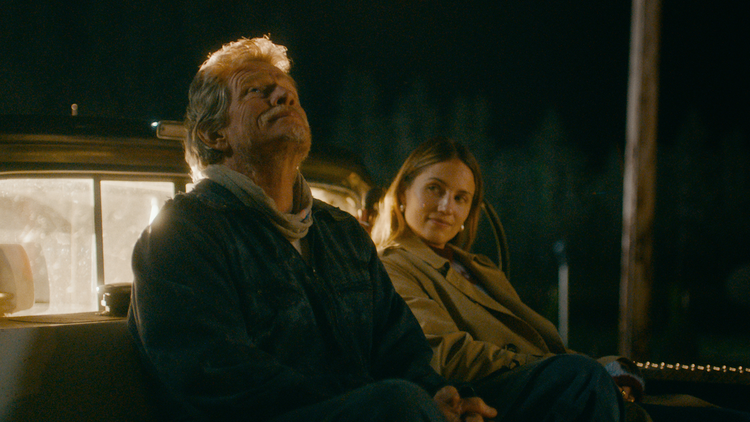
Acidman. Image source: Tribeca Film Festival.
David Lawrence, editor/co-producer of Lynch/Oz
How do you begin a project/set up your workspace?
It feels like it really begins with a conversation with the director — to wrap my head around what they’re going for and to do my best to tune into the wavelength of the project. When I sit down to start organizing footage and pulling selects, the one thing I might do a little differently than some is I have the note taking app Evernote open on one of my screens. I jot down any and all ideas that come to me as I explore the footage there, and inevitably I wind up revisiting these notes way down the road as we search for how to improve something. This is the beginning of a super elaborate process where I try to keep all my ideas and the director’s notes organized in a searchable “arm’s reach” way throughout the life of the project.
What were some specific post-production challenges you faced that were unique to your project? How did you go about solving them?
Well there’s one big glaringly obvious thing which is that we made a decision from the outset that the interviews would be audio only. So visually the film is basically wall-to-wall film clips and archival material. To actually make that work, the director and I had to boil every single sentence that’s spoken into a series of decisions for how to illustrate that sentence in an interesting way that also flows with everything around it. It took a whole lot of time and often felt like we were tightrope walking without a net, but we made it through and came out the other side with something that feels unique.
Share a photo of where you work. What’s your favorite thing about your workspace and why?
On the left I have this CalDigit TS3 Thunderbolt 3 Dock — it’s a lifesaver that allows me to run everything off of my laptop. On the right I’ve got this Dyson bladeless fan that people seem to be fascinated by and love sticking their hand through.
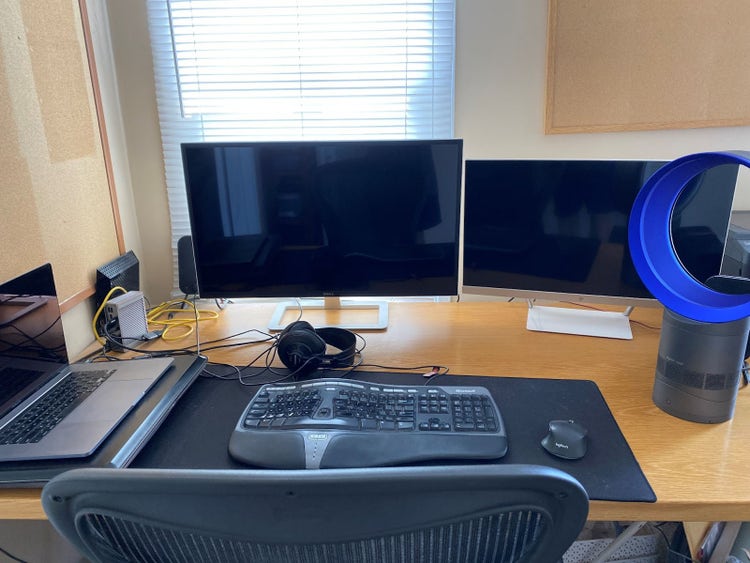
Image Source: David Lawrence.
Julian Robinson — editor and co-producer of It Ain’t Over
Tell us about a favorite scene or moment from this project and why it stands out to you.
I’d have to go with the first scene I fully cut, Yogi Berra Day 1999. It happens late in the film, and we started editing without actually having the game archival — just our interviewees describing this larger-than-life event. We found the game on YouTube (because every archival vendor was closed at this point in 2020), and not only did the scene come together incredibly quickly, it changed very little to this day, because it’s just so emotional at its core. I cried while editing it. Everybody cries watching it. Having that one scene clarified so much about the emotional magic of the film, and gave us so much momentum to build on while making a really joyful film at such a tough time in history.
Do you use Frame.io as part of your workflow?
We used Frame.io from the early stages, first for distributing dailies from interviews and pickup shoots. When you’re based in Los Angeles and collaborating with producers in New York, it’s nice to eliminate the guesswork about what you may have in an interview, or whether a moment in the transcript really plays out in footage. Later in the process, we used it for sharing rough cuts and gathering feedback from our producers. Independent films have a lot of collaborators involved, and it’s really useful to have notes from multiple parties all consolidated in one place, with timecode, downloadable as a text document.
Who is your creative inspiration and why?
In grad school I interned for the documentary filmmaker Albert Maysles. He ran his company like a family, having interns at his house for brunch on Sundays — genuinely interested in the lives of everyone around his projects. That’s why I work with filmmakers like It Ain’t Over director Sean Mullin, a friend and neighbor who assembles a dedicated film team that feels like a family. We both work with companies like Vanishing Angle, who very much bring their filmmakers together like family — my time with Albert Maysles showed me the higher purpose of pursuing creative collaborations with like-minded people who build lasting bonds in a freelance industry.
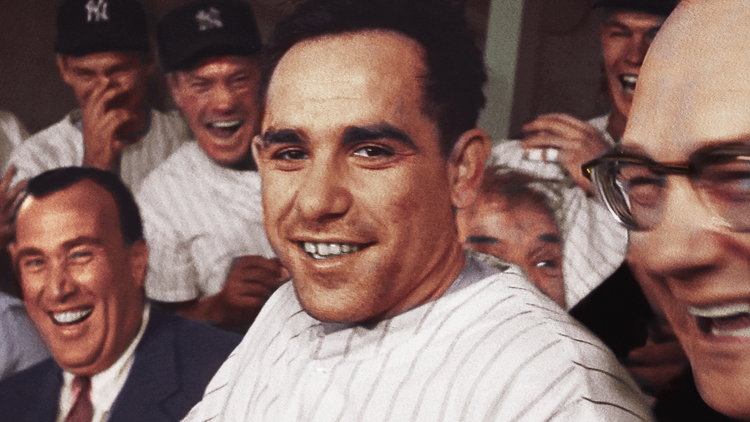
It Ain’t Over. Image source: Tribeca Film Festival.
Daniel Garber — editor of The Drop
How and where did you first learn to edit?
I first learned to edit when I was a high school student, armed with a consumer video camera and a bad idea for a web series. A much earlier version of Premiere Pro was my NLE of choice, and I spent long hours on my personal computer learning some rudimentary technical skills. (Needless to say, both the software and I have come a long way since then!) But I had no understanding of the creative process of editing — for that, I credit my first mentor in the film world, a veteran editor who I met by chance and stayed in touch with for years. I bombarded him with links to my juvenile short films, which he patiently picked apart — it was the best education I could’ve asked for as a teenage filmmaker.
What Adobe tools did you use on this project and why did you originally choose them? Why were they the best choice for this project?
We relied most heavily on Premiere Pro, though we ended up using several other Adobe tools in conjunction with it: After Effects and Photoshopfor graphics work, Auditionfor on-the-fly audio editing, and Media Encoder for prepping deliverables. The ease of using all of these powerful tools together was one of the huge benefits of staying in the Adobe ecosystem.... We also used Frame.io frequently in our workflow. Sarah and I were located on opposite coasts for much of the post process, and the pandemic prevented us from holding in-person test screenings. Frame.io made it easy to send out review links to each other and to test viewers, producers, and other collaborators. It’s thoughtfully designed in so many ways — from the link expiration feature to the ability to send review links with entire batches of clips, Frame.io has all of our bases covered.
Who is your creative inspiration and why?
I’m lucky to have a lot of creative inspirations in my life, though I’m particularly grateful to have worked with Sarah on this film. She’s taught me a lot — not only about the art of filmmaking, but about being a good creative collaborator. As a seasoned director and editor, her only interest is in making the film better, so she does an incredible job of checking her ego at the door and is unsparing in her criticism of her own work. She has no attachment to ideas that aren’t working and pivots decisively when she sees a better way forward. She’s also a generous collaborator who builds up her team — after yelling “cut” on set, the first word of out of her mouth was always one of encouragement, no matter how pressed for time she felt. Under pressure, she becomes incredibly focused, without showing any signs of stress or letting it infect her rapport with her actors. That kind of poise is something every filmmaker could learn from.
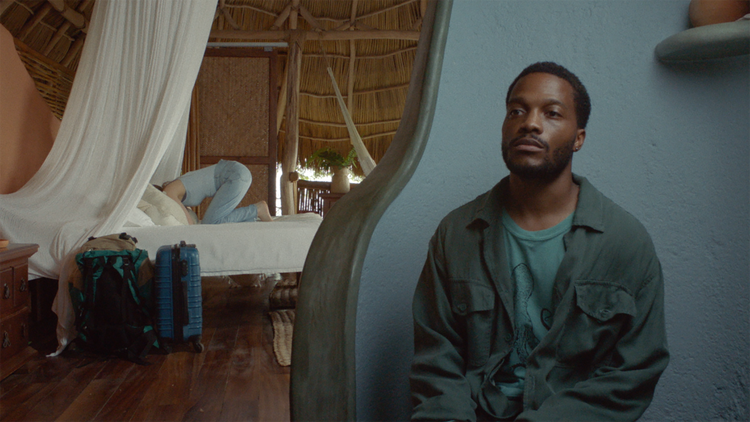
The Drop. Image source: Tribeca Film Festival.
Bryan Mason editor/cinematographer of Good Luck To You Leo Grande
How and where did you first learn to edit?
I first came across editing as a teenager. I grew up skateboarding and one summer a group of us hired a camera and filmed ourselves for a couple of weeks. Just before we had to take the camera back, I took the tapes and put together a very rough edit of a skateboarding video, working from the VHS-C camera to a VHS deck, play record, pause, cue, play-record style. It was both infuriating and exhilarating in equal measures.
How do you begin a project/set up your workspace?
I edit standing up, I made the transition to a standing work station about 5 years ago and it really changed things in a great way for me. Once your body is used to it, which can take a couple of weeks, you can finish a 10/12 hour work day and not be physically wrecked. In fact I often finish an edit day mentally taxed for sure but physically fine, which is in stark contrast to my experience with editing sitting down.
What were some specific post-production challenges you faced that were unique to your project? How did you go about solving them?
This film is ostensibly a two hander, two people in one room for 80 — of the narrative, so keeping that interesting and amusing was certainly the biggest challenge in the making of this project for me. Thankfully Sophie Hyde the director elicited two magnificent performances from our stellar cast, then it was a matter of trusting the material in the edit and letting it play out in a way which was true to the intention of the script and honoring the best of what the actors offered.

Good Luck to You, Leo Grande. Image source: Tribeca Film Festival.
Harrison Atkins — editor of Good Girl Jane and The Year Between
Tell us about a favorite scene or moment from this project and why it stands out to you.
In Good Girl Jane, the majority of the film was shot in long oners, which was both a blessing and a curse for our post-production process, since so much of what could make or break a scene was already directly embedded in the take as shot. So other than being extremely incisive and judicious with the in and out points and the order of scenes, I had to use lots of sneaky tricks to enhance the magic of the takes we chose. The film has some hidden ghost cuts that I’m really proud of — though I won’t tell you where they are. In general that project was such a lovely and nourishing collaboration with the director Sarah Elizabeth Mintz — I’m proud of our friendship and how we worked together.
The Year Between was written and directed by my friend Alex Heller, whom I’ve known for many years. She wrote what I imagine to be an amazing, funny, heartfelt script for the film. I say “imagine” because we decided that as an experiment I wouldn’t read it before starting my work. To this day, I haven’t. The result was that in the edit I had no sense of the “myth” of the film, no frame of reference for what scenes were supposed to be. Thus, I was afforded a rare privilege of experiencing the footage in a very direct way, which I think served our collaboration a lot and allowed the film to bloom into a completely organic and alive version of itself.
What Adobe tools did you use on this project and why did you originally choose them? Why were they the best choice for this project?
I predominantly used Premiere Pro for both of these films, 99 percent of the time, with the very occasional experiment in After Effects or Photoshop. I started working in Premiere originally as a refugee from Final Cut Pro 7… I never made the switch to FCPX, and instead ported all of my hotkeys and stuff from FCP into Premiere Pro. I’ve become very comfortable using the program — it’s all muscle memory, so I can essentially execute an idea as soon as I’m imagining it. I think that low latency between idea and execution is what’s most important to me when choosing a tool for this kind of work. We used Frame.io pretty extensively on The Year Between, mostly after the cut was locked, to share various assets and exports amongst post departments.
What’s your hidden gem/favorite workflow tip in Adobe Creative Cloud?
I love to be a bit sneaky with slow motion and optical flow time interpolation in Premiere Pro. It’s so useful when you want to hold on a shot or moment for a few extra frames that otherwise wouldn’t exist. I’ve had some fun on experimental projects doing crazy stuff with optical flow. There was a thing I made last year by exporting a sequence super over-cranked and then slowing it back down to real time with optical flow. Then I repeated that process over and over again, until the majority of the clip consisted of weird, gooey optical-flow interpolation frames.

The Year Between. Image source: Tribeca Film Festival.
Nick Garnham Wright — editor for On the Line: The Richard Williams Story
Tell us about a favorite scene or moment from this project and why it stands out to you.
Venus major tournament debut at the 97 US Open was one of the first sequences I cut for this project, and it made it all the way through into the final cut. It’s the first sequence in the film you really get to see Venus’ tennis talents shine, flying in the face of the pressure and negative hype from the tennis establishment surrounding the Williams family at that time. Highlighting the interplay between those two extremes, while cutting to a driving, pseudo-western score (Tennis matches are essentially duels) was exciting.
Who is your creative inspiration and why?
This is a tough one, because it’s always changing. My dog is high on the list though.
What’s the toughest thing you’ve had to face in your career and how did you overcome it? What advice do you have for aspiring filmmakers or content creators?
Toxic/abusive work environments. This hasn’t been a problem so much recently, but as a younger editor, I didn’t always know how to recognize or address the bad situations that can arise when you’re starting out and taking any job you can. Developing a strong sense of perception and self-worth helps identify worthwhile opportunities, while honing communication skills helps you handle issues honestly and directly should they arise. Lastly, never be afraid to take care of yourself by exiting an unhealthy situation.
What Adobe tools did you use on this project and why did you originally choose them? Why were they the best choice for this project?
We used Adobe Premiere Pro (Productions) for editorial, and Media Encoder to batch transcode when necessary. Productions allowed us to compartmentalize our media assets to distinct/individual projects, stay organized, and prevent any singular project from getting too bloated. Given the aforementioned volume of archival assets, Productions was really the only choice. We also used Frame.io. My favorite part about Frame.io is the upload speeds. It makes posting cuts for review quick and painless.
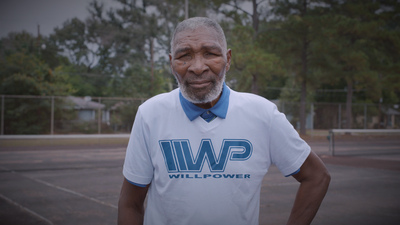
On the Line: The Richard Williams Story. Image source: Tribeca Film Festival.
Daniel Antebi — director/writer/editor of God’s Time
How and where did you first learn to edit?
I learned to first edit when I was in 7th or 8th grade at the Washington International School with Mr. Moran. It was on Adobe Premiere. I immediately loved it. From there I was creating little shorts and learning mostly on YouTube.
Who is your creative inspiration and why?
Ricky Martin. Zorro. My Mexican-Jewish family. My wildly creative partner Annabelle Martin. The Safdies. Barbra Loden. Pale Siersen Frost. Claudia Rankine. Pedro Almodovar. Robert Ostlund. Fellini. Ira Sachs. And so many more. All of them because they refract and reflect the world into a more vibrant and loving place — especially when they do it with a dark and chaotic hand.
What’s the toughest thing you’ve had to face in your career and how did you overcome it? What advice do you have for aspiring filmmakers or content creators?
Whether it’s an institution or a person not wanting to work with you, rejection is the toughest thing. But if you persist, the right people fall into place. My advice to aspiring filmmakers and artists: the difference between artists and non-artists is that artists make art. It’s that simple. Find your community and make things.
Share a photo of where you work. What’s your favorite thing about your workspace and why?
My window is my favorite thing about my workspace because I remember outside exists.

Image source: Daniel Antebi.
Mike Selemon — editor, LAND OF DREAMS
How and where did you first learn to edit?
I first learned to edit technically using tape-to-tape decks in high school, then some film cutting and digital editing at Purchase College. Once I began working in the industry as a post-production assistant, I was lucky to work with an editor and assistants who were quite generous in showing me both the technical and creative sides of movie editing.
What were some specific post-production challenges you faced that were unique to your project? How did you go about solving them?
One particular challenge of Land of Dreams was a dinner sequence, in which Isabella Rossellini’s character calls in via video (very apropos of the COVID-19 era). Ms. Rossellini’s part was filmed months after the main production unit, and by then, Shirin, Shoja, and Isabella began experimenting with a new direction for her character. Joining both elements in the cut proved to be tricky at times, but we ultimately arrived at a wonderfully bizarre and funny place, after lots.
What Adobe tools did you use on this project and why did you originally choose them? Why were they the best choice for this project?
Land of Dreams was cut using Adobe Premiere, and our NYC assistant editor, Nancy Galvan, and VFX supervisor, Dara Hamidi, used Frame io to shuttle shots back and forth. I appreciate how intuitive Premiere Pro is. I had only used it briefly before Land of Dreams, and jumping into the deep end with a feature film proved to be easier than expected.
Who is your creative inspiration and why?
It may sound corny, but as we made our way on this journey that is Land of Dreams, Shirin and Shoja were incredibly inspirational to me. They are so thoughtful and generous, and have a wonderfully unique view of the world. And in terms of collaborating, they were open to looking at material in a new way — something that is crucial for a director. Their willingness to experiment allowed me the freedom to play with sequences and ultimately arrive at the film we see today.